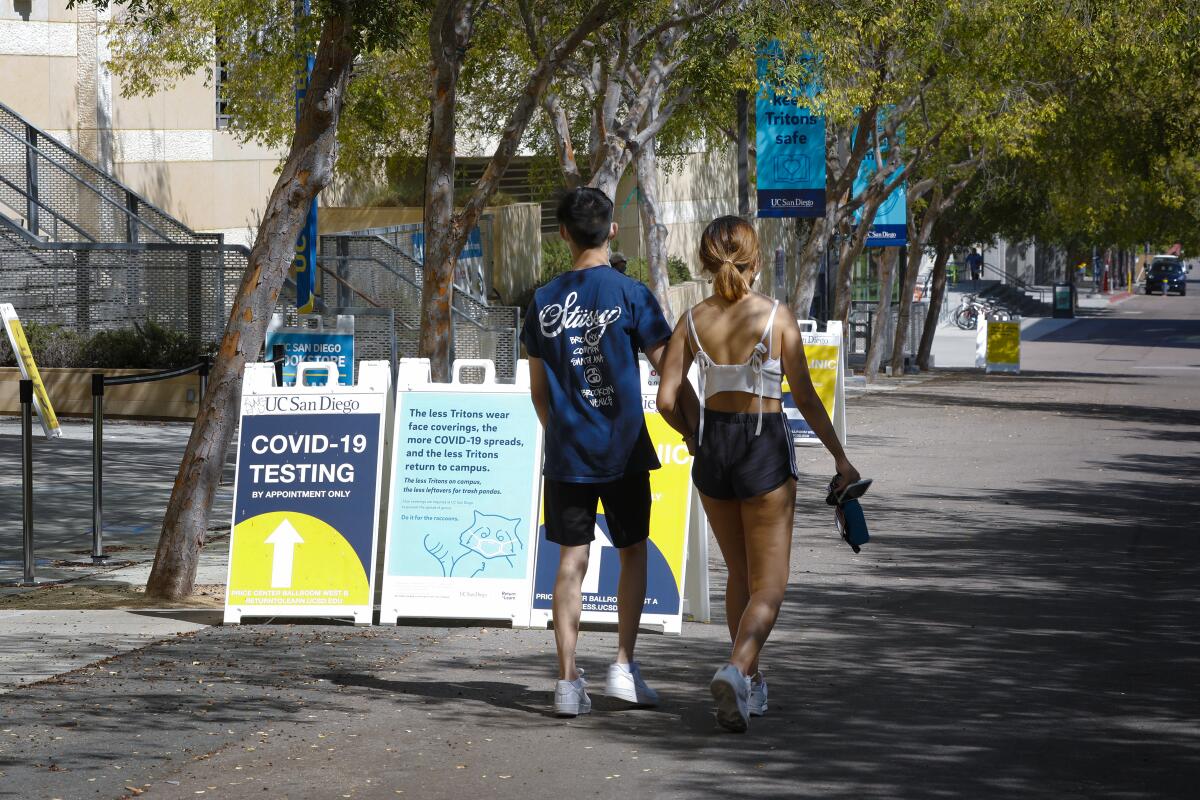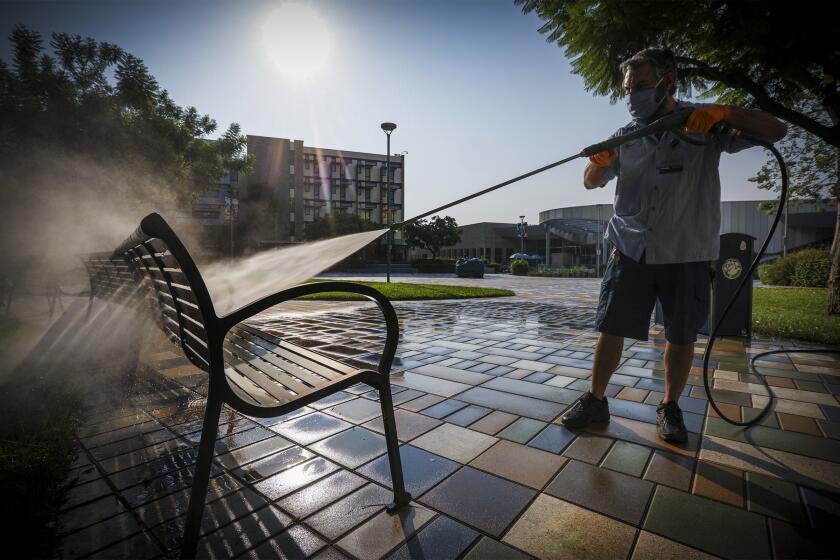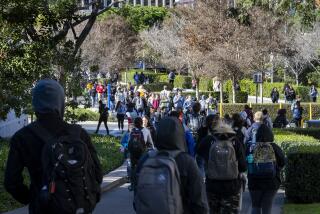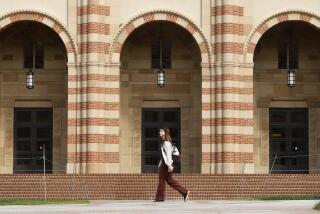Serious COVID-19 outbreaks hit California colleges despite intense preparation
- Share via
This fall, as colleges around the country wrestled with how to reopen amid the coronavirus crisis, officials in California required a cautious approach. Classes were put online, isolation rooms were set up on campus, and restrictions were placed on the number of students permitted to live in dormitories or come on campus.
But what deans and provosts couldn’t control were the thousands of students who returned to fill apartments and houses in neighborhoods surrounding their schools, determined to salvage some semblance of a college experience.
Unchecked by campus rules and safeguards, these students became fertile ground for the virus, which has spread rapidly on and around several California campuses despite sparsely populated dormitories and classrooms. From San Diego to Chico, the outbreaks have thrown universities into crisis mode as they scramble to slow the virus’ spread with tighter restrictions and attempts to cajole students into safer behavior.
With so many students living in close quarters and often pressing ahead with parties and other gatherings that disregard social distancing guidelines, some experts said school officials’ hopes of keeping the virus at bay with remote learning were unrealistic.

“I think it’s inevitable that colleges are risky environments,” said Kirsten Bibbins-Domingo, chair of UC San Francisco’s Department of Epidemiology and Biostatistics.
“One of the essential elements of college in general is that you have a bunch of people who have not been with each other, traveling and coming together in one location, living in an environment in close quarters and generally having an experience where interacting with one another is an essential feature,” she said.
At Cal Poly San Luis Obispo, where more than 130 people have been infected with the virus since the start of the school year, officials last week were left pleading with students not to gather in large groups after video of a raucous and tightly packed beach party surfaced.
Fewer than 2,500 students at San Diego State University were allowed to live in on-campus dorms and only about 6,240 students are taking in-person classes — slivers of the 35,485 students enrolled at the school. But while school administrators implemented a widespread testing strategy for students on campus, required anyone who tested positive to quarantine in isolation wards, and reorganized dorms to give everyone their own room, they were powerless to force students living off campus to participate in the safety requirements.
The virus took hold. University officials announced 120 new cases on Sept. 4 and in less than a week that number had more than quadrupled to 509 cases. The school paused in-person classes, but cases have continued to mount. As of Oct. 5, the university had reported more than 1,110 confirmed infections with more than 50% of them connected to students living off campus.
“You can’t isolate, as if it’s on an island, a campus community that’s part of a larger community,” Gov. Gavin Newsom said recently when asked whether the university’s high number of infections should count against San Diego County’s efforts to reopen.
It was a similar scene at Chico State University in Northern California, where officials cut the number of students living on campus from about 2,200 to 750 in hopes that returning students would not spread the illness in a county that had seen relatively few cases. But about 10,000 students took up residence in a one-mile radius around the school.
The first cases of the coronavirus among Chico students arose in early August before the start of classes, and the situation got worse from there. By the end of the month, in-person classes were halted and students were told to leave campus after 30 people contracted the virus. In the weeks since, the number of cases has ballooned to more than 190, with two-thirds linked to off-campus students.
“It’s such a wild card for us — it’s a wild card for any college town,” Debra Larson, provost and vice president for academic affairs at Chico State, said of the thousands of students living off campus. “You can tell them, ‘Don’t come,’ of course. But they were coming.”
In California, schools’ reopening plans have been guided largely by a tiered rating system the state has devised to measure the prevalence of the virus in a particular county. A university in a county that remains mired in the first tier, where risk of infection remains high, would not be allowed to resume in-person classes — with the exception of certain classes such as labs or studio work — while a school in a county that had progressed to a higher tier could.
As schools reopen, the virus continues to hit campuses in waves. Cal State Long Beach recorded at least 22 cases more than a month after the school reopened. UC Berkeley, which has reported more than 225 cases, is considering a plan to more fully close off the campus from the public. Under the plan, university employees would monitor visitors and check their reasons for coming to the school.
Like other schools, USC has tried to wrangle the thousands of students living on the blocks around its campus south of downtown Los Angeles despite there being no in-person classes.
“We’re actively doing outreach to students living around campus to encourage them to get tested weekly,” said Dr. Sarah Van Orman, associate vice provost for student affairs and chief health officer.
About 3,000 students have been tested weekly for the virus, and the university has a team of about 30 contact tracers working to identify close contacts of those who test positive.
The steps have failed to stop the virus. With more than 500 cases reported since early July, the school has had about 2,000 students living at some point in isolation facilities or quarantined. The infections among students have been linked largely to parties and other off-campus gatherings, and officials are trying to enforce restrictions beyond campus borders. Students who disobey rules prohibiting large gatherings, for example, face potential discipline, including expulsion.
But the assistant chief of the school’s Department of Public Safety, David Carlisle, said the university has focused on offering students resources to correct risky behavior. Information about students who have reportedly hosted gatherings is typically sent to the Student Compliance Committee, which sends educational material to the individual in the form of a letter.
Young adults are most likely to develop asymptomatic cases of the coronavirus. In California, which has recorded more than 833,000 infections, college-age adults ages 18 to 22 have accounted for more than 77,100 of those infections, according to the California Department of Public Health.
Those numbers reflect a harsh reality for universities and colleges that outbreaks among college students may be nearly impossible to prevent. And while some schools elsewhere in the U.S. have opted to avoid the risk of outbreaks by remaining closed altogether and others have opened fully, in California schools have tried to strike a balance between opening and mitigating the risk posed by the virus.
“Colleges that were already at the edge of the financial precipice potentially could be pushed over the edge into permanent closure because of the pandemic,” said Mark Kantrowitz, publisher and vice president of research at financial college guide Savingforcollege.com.
Peter Herman, an English professor at San Diego State, questioned the course the school has forged.
“Why did the university bring back students to campus in the first place, when an outbreak was obviously a possibility?” he wrote in a recent opinion column. “What safeguards did the university have in the dorms to ensure compliance? ... How is the university to control the behavior of students who do not live on campus?”
California has fared better than other states where university officials chose to reopen more fully and were quickly confronted with surges of cases, such as Georgia and South Carolina. Such campus reopenings drove a spike of about 3,000 new cases a day in the United States, according to a preliminary study posted this month.
According to the Centers for Disease Control and Prevention, weekly reports of COVID-19 among people ages 18 to 22 rose by more than 55% from Aug. 2 to Sept. 5. The increases were greatest in the Northeast and the Midwest, aligned with several university reopenings throughout the country.
Bibbins-Domingo said that regular testing from the time a student arrives on campus is crucial. Reports of infection are likely, but the goal should be to mitigate the spread. “Your goal is to make sure those outbreaks are small enough to contain,” she said, comparing it to the firefighting strategy of containing a brush fire before it explodes into a full-fledged blaze.
At UC Irvine, the 7,000 undergraduate and graduate students allowed to live on campus arrived in staggered waves last week in an attempt to minimize interactions. Their numbers are down 40% from a typical year.
School officials plan to test the on-campus students weekly for the virus, as well as anyone who visits campus. Interim Provost Hal Stern said the school was prepared to switch entirely to remote instruction if cases flared up. A team of 10 contact tracers has been deployed to track those at risk as soon as someone tests positive.
UCLA has similar plans in place, with only 700 students living on campus — 5% of the normal capacity. They and the several thousand other students in off-campus housing owned by the university will be tested regularly. But the thousands of other students renting apartments in the hills around the campus are deciding for themselves how to live.
More to Read
Sign up for Essential California
The most important California stories and recommendations in your inbox every morning.
You may occasionally receive promotional content from the Los Angeles Times.













